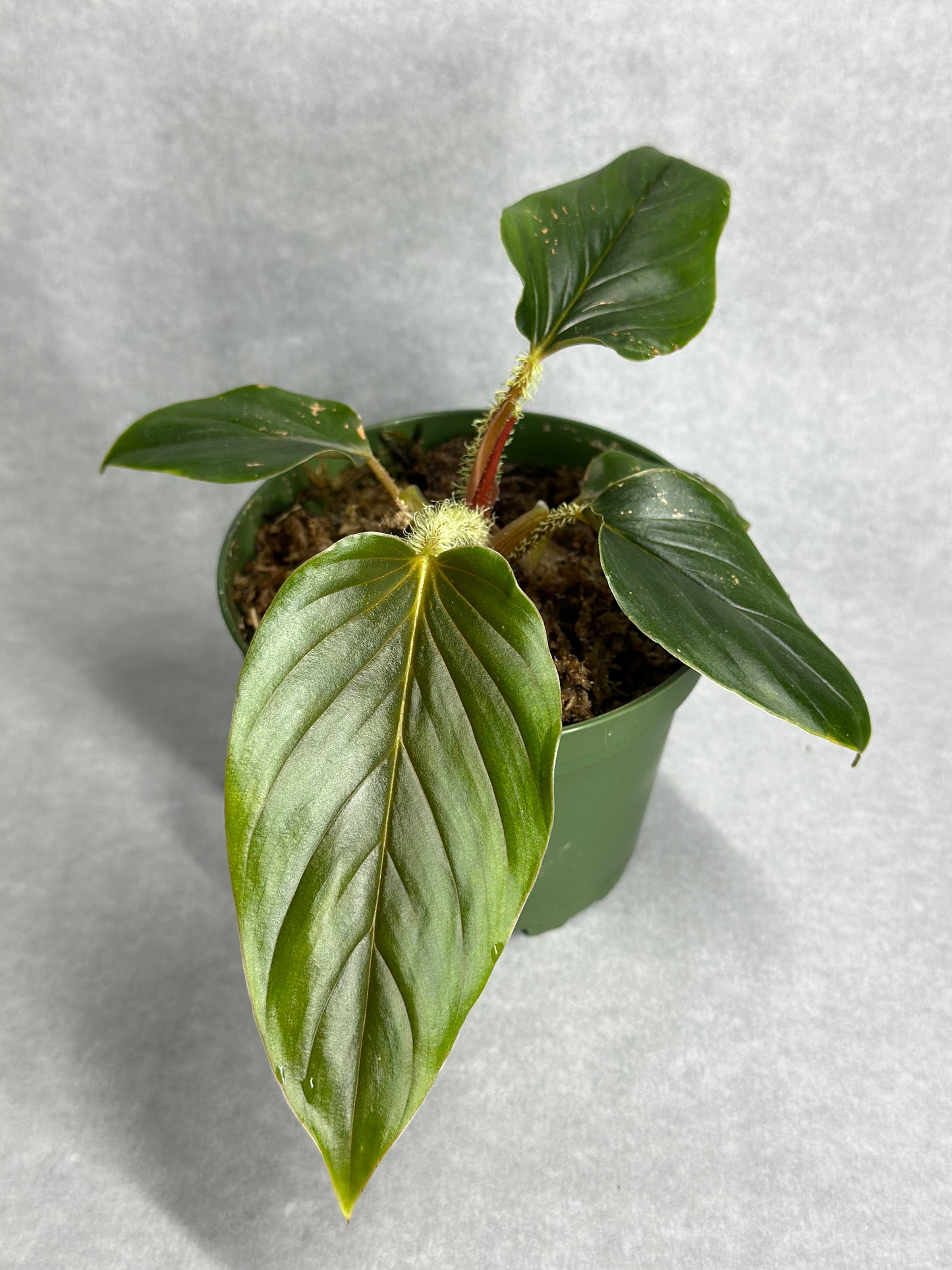Philodendron serpens
Philodendron serpens
Out of stock
Couldn't load pickup availability
Philodendron serpens is a unique and visually striking species within the Philodendron genus, known for its large, heart-shaped leaves and its distinctive, bristly petioles. Native to the tropical rainforests of Central and South America, Philodendron serpens is a highly sought-after plant among collectors for its bold appearance and relatively easy care requirements.
Morphological Characteristics:
-
Leaves: The leaves of Philodendron serpens are large, heart-shaped, and typically measure 20-40 cm (8-16 inches) in length and 15-30 cm (6-12 inches) in width, depending on the plant's maturity. The foliage is a deep, rich green with a slightly glossy surface, which adds to its lush, tropical appearance. The veins of the leaves are often prominent, giving the foliage a textured look. The leaves have a slight leathery feel, and their broad, heart-shaped form makes them a focal point in any plant display. As the plant matures, the leaves can become even more pronounced in size and shape, adding to the overall drama of the plant.
-
Petioles: One of the most distinctive features of Philodendron serpens is its petioles (leaf stalks), which are covered in dense, reddish to brown bristles. These bristles give the plant a unique texture and add an interesting contrast to the smooth leaves. The petioles are thick and sturdy, providing strong support for the large leaves. The bristly texture of the petioles is a key identifying characteristic of this species and contributes to its popularity among collectors.
-
Stems: The stems of Philodendron serpens are thick and sturdy, typically green, and may develop a slight reddish tint, particularly near the nodes. The plant produces aerial roots along the stems, which help it cling to surfaces as it climbs. These aerial roots are also an adaptation that allows the plant to absorb moisture and nutrients from the air in its natural habitat.
-
Growth Habit: Philodendron serpens has a climbing or vining growth habit, making it ideal for training on a trellis, moss pole, or other support structures. In its natural environment, the plant can climb trees and other surfaces to great heights, but in cultivation, it typically reaches 1.5-2.5 meters (5-8 feet) with proper support. The plant’s moderate growth rate and large, dramatic leaves make it an excellent choice for adding a touch of tropical elegance to indoor spaces.
Ecological Preferences:
-
Light: Philodendron serpens thrives in bright, indirect light but can also tolerate lower light conditions. Providing brighter, filtered light will encourage more vigorous growth and help maintain the deep green coloration of the leaves. Direct sunlight should be avoided, as it can cause the leaves to scorch or fade. If grown indoors, placing the plant near an east or north-facing window with filtered light is ideal.
-
Soil: This plant prefers a well-draining, rich soil mix that retains moisture without becoming waterlogged. A mix of peat moss, perlite, and orchid bark is ideal, providing both moisture retention and aeration needed for healthy root development. The soil should be kept consistently moist but not soggy, as philodendrons are prone to root rot if left in overly wet conditions.
-
Water: Water Philodendron serpens when the top 2-3 cm of soil feels dry. The plant enjoys consistent moisture, especially during the growing season (spring and summer), but care should be taken to avoid overwatering. During the dormant period (fall and winter), reduce watering frequency slightly, allowing the soil to dry out more between waterings.
-
Humidity: This plant thrives in high humidity levels, ideally between 60-80%. Higher humidity helps maintain the lush, vibrant texture of the leaves and encourages healthy growth. Using a humidifier, placing the plant in a bathroom, or regularly misting the plant can help maintain optimal humidity indoors.
-
Temperature: Philodendron serpens prefers warm temperatures, ideally between 18-26°C (65-80°F). It is sensitive to cold drafts and should be protected from temperatures below 15°C (59°F). Consistent warmth and stable conditions will help keep the plant healthy and encourage continuous growth.
Additional Care Tips:
-
Fertilization: Feed Philodendron serpens with a balanced, water-soluble fertilizer every 4-6 weeks during the growing season. A fertilizer formulated for tropical foliage plants is ideal, supporting the development of large, healthy leaves. Avoid fertilizing during the winter months when the plant’s growth naturally slows.
-
Pest Management: This plant can be susceptible to common houseplant pests such as spider mites, mealybugs, and aphids. Regularly inspect the plant, particularly the undersides of leaves and along the stems, and treat any infestations promptly with insecticidal soap or neem oil. Maintaining proper watering practices, high humidity, and good air circulation will help reduce the risk of pest issues.
Share!


Terms of Sale
The cover photo of each product represents the current crop, you will receive a plant of a similar size and quality from the ones pictured.
Upon purchase of this plant, you are agreeing to the terms and conditions of this sale. For further details, please refer to our business Terms and Conditions.
For any further inquiries, please feel free to shoot us an email at team@foliatefl.com.


